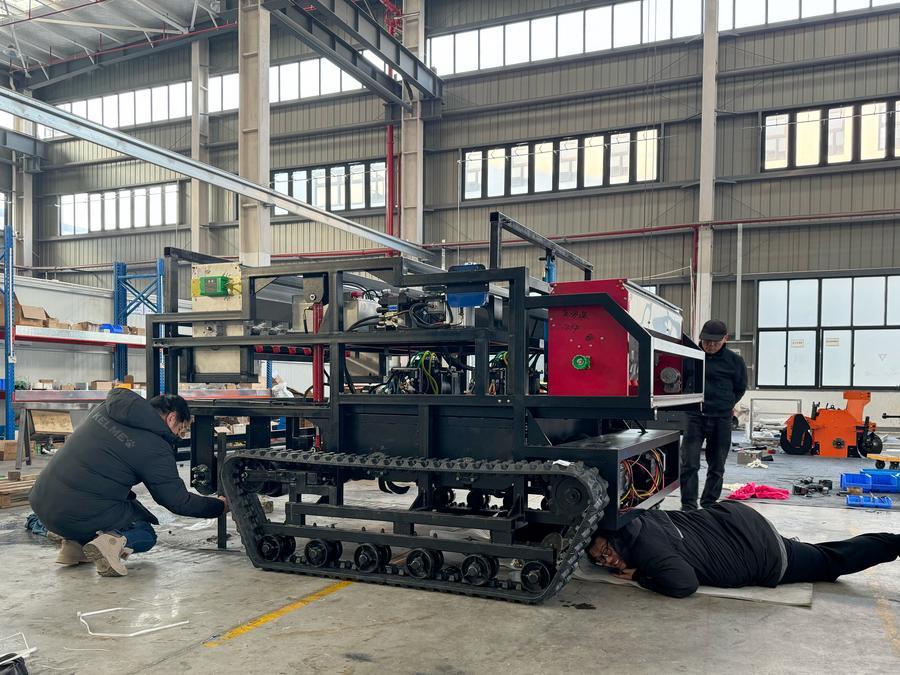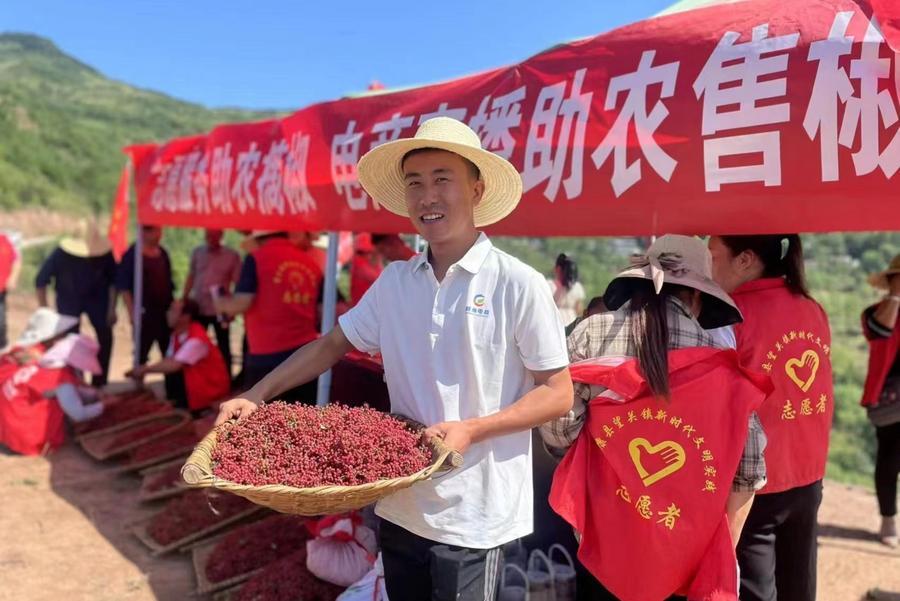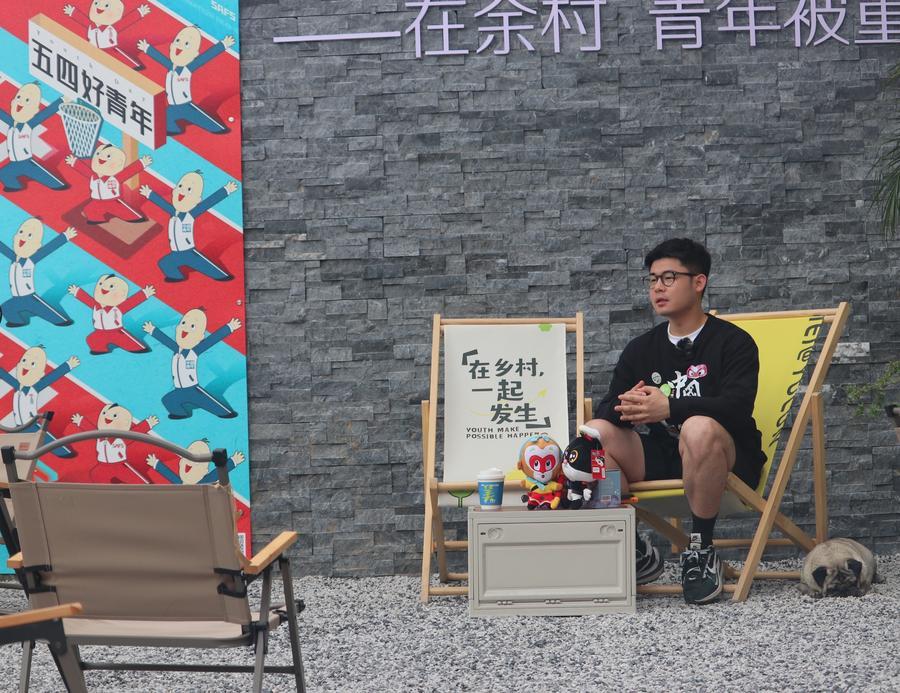Back to countryside, new trend amid China's rural revitalization drive
Xinhua, February 29, 2024 Adjust font size:
After graduating from university, Wang Jinyue had to work incredibly hard to become a manager of an Internet company in the eastern metropolis of Shanghai. When the post-85s man quit his job in 2017 and returned to his rural hometown, it was hard for his parents and friends to understand.
After all, over the past few decades, pursuing higher education and then settling down in urban areas has been predominantly regarded by rural Chinese families as the best way out for their offspring. As rural migrant workers flocked to urban centers in pursuit of better opportunities, they sought to use their modest incomes from factory or construction work to improve their families' financial standings. This influx of laborers fueled the rapid expansion of the urban economy.
China is not alone. "Throughout the history of human development, rural decline in the process of urbanization and industrialization has become a common challenge facing the world," said Li Yuheng, a researcher at the Institute of Geographic Sciences and Natural Resources Research under the Chinese Academy of Sciences.
China's economy has been accelerating its transition to a new growth model that pursues higher quality and better structure in the new era. In 2017, China began to implement the rural revitalization strategy to address the imbalance between urban and rural areas and between regions. Four years later, China announced it had secured a "complete victory" in its fight against poverty, embarking on a new journey of comprehensively promoting rural revitalization.

With the country's policy support and continuous investment in technology and public facilities in rural areas, there has been a trend of population flow in the opposite direction in China. More and more "new farmers," mostly well-educated young people with new ideas and skills, began to move from big cities to the countryside. They are bringing urban and rural areas closer together and addressing challenges with innovative solutions.
MODERN FARMING
Seven years ago, Wang Jinyue not only returned to his village in Tinglin town of Jinshan District, Shanghai, but also brought more than 70 engineers with him. He is now chairman of Shanghai Diantian, an agricultural cooperative.
"I grew rice with my parents when I was a child, and I know all too well the hardship of farm work," Wang recalled.
With the desire to empower farmers and alleviate the toil of agricultural work, Wang, along with his team, threw himself into the research and development of agricultural machinery and equipment. Subsequently, a futuristic scene of farming began to play out in Tinglin Town. Guided by cutting-edge technologies such as satellite navigation system and 5G signals, an AI farming robot had taken over the task of plowing the field. Farmers can now simply log on to a WeChat app account with their mobile phones and control the robot with an app.
"The accuracy of the robot's driving error is within 2 cm. Its operating speed can reach 3 to 5 km per hour, which is equivalent to several days of plowing for a farmer," said Wang.
As China's population ages, the digital transformation of agriculture effectively makes up for the shortage of employees, Wang said.

According to Wang, the cost of sowing has dropped over 37 percent thanks to robots powered by new energy. In fact, costs across the board from weeding to fertilization have all dropped, which has helped to increase farmers' income.
Over the past seven years, Wang's team has developed over 60 types of farm robots, ranging from plowing, planting, spraying, and weeding to harvesting.
China unveiled its "No. 1 central document" for 2024 early this month, outlining the priorities for comprehensively promoting rural revitalization this year. The document calls for efforts to strengthen the role of sci-tech development in promoting rural revitalization.
Data from the Ministry of Agriculture and Rural Affairs shows that the contribution rate of China's agricultural science and technology progress reached 62.4 percent in 2022. Aided by increased contributions from agricultural machinery and technology, China secured a grain harvest of over 650 million tonnes for the ninth consecutive year in 2023.
EXTENDED NETWORK
As rural revitalization continues to advance in China, Internet infrastructure is rapidly extending to out-of-the-way rural areas. By the end of 2022, China's rural Internet users exceeded 300 million. Rural China is more connected to the rest of the world than ever before, making it easier for villagers to find jobs locally and access customers farther away.
Also in 2017, Wang Xiehong, who has accumulated rich experience in Internet marketing after two years' work in an e-commerce company in Beijing, persuaded four of his fellow townsmen to return from cities to their rural hometown in Longnan, northwest China's Gansu Province, where they started an e-commerce company.

Boasting a pleasant climate, Longnan is rich in natural resources. However, local specialties such as olive oil, honey and pepper were once confined to the mountainous area due to limited ways of transportation.
While Wang worked his way up from the customer service desk to operations manager in Beijing, local authorities in Longnan were vigorously promoting the development of rural e-commerce, opening up a new channel for underdeveloped areas in the western regions of the country to enhance agricultural efficiency and boost farmers' income.
"The country's support policies for rural areas are so strong that there is more room for rural development than ever before," Wang said. "We go home to start a business, on the one hand, to sell the local agricultural products to the outside world, and on the other hand, we can also develop better."
Wang's company opened several stores on Taobao, the country's leading online shopping platform, and Douyin, the Chinese version of TikTok. The company's sales reached 2.6 million yuan (about 366,000 U.S. dollars) in 2019, enabling more than 400 households of farmers to increase their income. Last year, supported by the local government's favorable agriculture policies, Wang and his partners also built a standardized processing plant to upgrade the packaging of local specialties, providing more jobs for local residents.
According to the Ministry of Agriculture and Rural Affairs, as a result of the robust rural e-commerce, China's online retail sales in rural areas surged to 2.49 trillion yuan in 2023. Data from the National Bureau of Statistics shows that rural per capita disposable income hit 21,691 yuan last year, up 7.6 percent from the previous year.
This year's "No. 1 central document" has for the first time proposed to implement high-quality development projects for rural e-commerce, promote the construction of county-level e-commerce live broadcast bases, and develop the online sales of rural local specialties.
In addition, a logistics network is also being rolled out across China's vast rural areas. For instance, Longnan has improved rural logistics infrastructure in recent years with a three-level logistics system, featuring nine county and district-level unified distribution centers, 199 township service stations, and 2,404 village-level service points. Now, the typical delivery time has been reduced from about one week to just two or three days in the rural region.
BEAUTIFUL COUNTRYSIDE
When Chen Zhe, who had been working in brand marketing in Shanghai, returned to his home in Yucun Village in Anji County, east China's Zhejiang Province, in 2022, he initially only planned to stay for a day or two. However, his visit ended up stretching to three months. Local authorities were recruiting "global partners" and invited more than 60 young people, including Chen, to develop new business models for the village.
"It's pretty bold for a small village to solicit talent from all over the world," Chen said.
As a village rich in high-quality limestone resources, Yucun experienced environmental deterioration as more than half of its locals relied on quarrying in the 1980s and 1990s. In 2003, Zhejiang launched the Green Rural Revival Program. It began with a mission to improve rural living conditions by renovating approximately 10,000 incorporated villages in five years, and by transforming about 1,000 of that number that were classed as central villages into examples of moderate prosperity in all respects.

Thanks to the program, Yucun embarked on a path of green development by boosting its eco-tourism industry. It has now become a model of China's beautiful countryside after two decades of relentless efforts. In 2021, it was named one of the "Best Tourism Villages" by the United Nations World Tourism Organization.
"The rural areas are becoming more and more attractive to young people," said Wang Yucheng, Party chief of Yucun. "The global partners program is not simply an investment project, but rather an initiative aimed at attracting like-minded young people to start businesses and promote green development. Yucun will provide them with an entrepreneurial environment and a solid platform."
Chen and his team, all of whom are under the age of 30, opened a Chinese comic-themed cafe in the newly built youth library in Yucun in March last year.

"It feels like Yucun is a laboratory with many possibilities, and it can inspire the development of villages across China," Chen said.
The "No. 1 central document" this year also stressed the need to utilize the experience gained from the Green Rural Revival Program in advancing the country's rural revitalization.
"Rural revitalization depends on people, especially young people with ideas and vitality," said He Miao, Party chief of Tianhuangping Town, which administers Yucun Village.
She noted that since the village's global partners program was launched in July last year, 42 projects have been introduced there, covering research and education, cultural creativity, the digital economy, and the agriculture and forestry industries. The program has attracted over 1,100 young people from home and abroad to work and live in Yucun and its surrounding villages.

In a bid to retain young people, the rural areas of Zhejiang are making strides to provide them with the same public services as in cities. A digital service center built in Xiantan Village, Deqing County, is equipped with a health clinic, a childcare center, a gym, and a dance studio, providing one-stop services ranging from childcare to elderly care. Cultural spaces such as libraries and art galleries are now a common sight across rural Zhejiang, another attraction for new farmers.
"The countryside should be rich not only in material life but also in spiritual life. So projects like the Xiantan Art Museum are indispensable," said Fei Minjun, chairman of Xianzhitan, a tourism company based in Xiantan Village.
(Reporting by Cui Enhui, Song Changqing, Zhang Wenjing, Lang Bingbing, Zhao Yihe, Sun Zhenghao, Yao Youming; Video reporters: Zhao Yihe, Sun Zhenghao, Lang Bingbing, Zhang Wenjing; Video editors: Zhang Mocheng, Hui Peipei, Liu Xiaorui)
